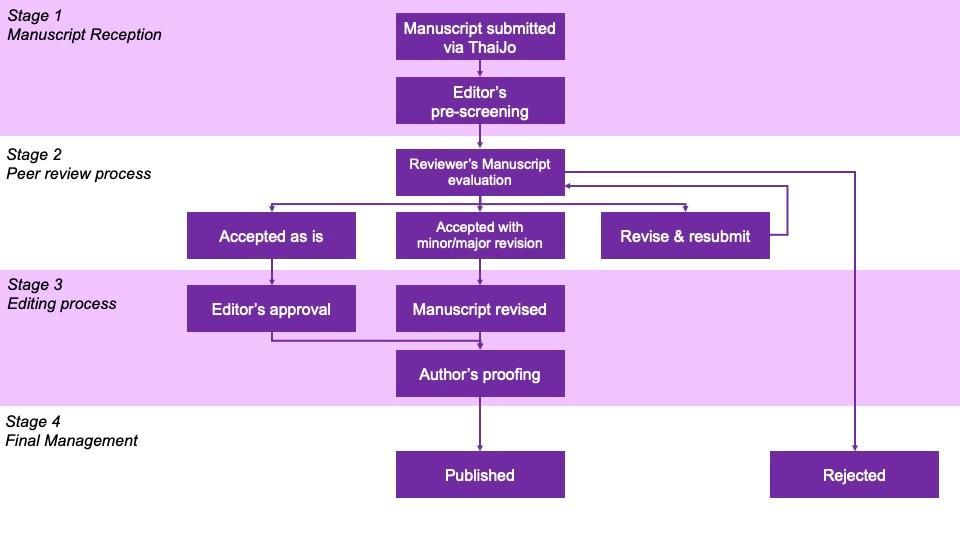Submissions
Submission Preparation Checklist
As part of the submission process, authors are required to check off their submission's compliance with all of the following items, and submissions may be returned to authors that do not adhere to these guidelines.
- The manuscript must be an original work that has not been published elsewhere and that is not being considered for publication in any other journals.
- The submission file is in OpenOffice, Microsoft Word, or RTF document file format.
- The manuscripts must have been edited for language quality before submission. If the manuscript does not reach an academically appropriate standard of English, it will be returned to the author for edition before a peer review process.
- Where available, URLs for the references have been provided.
- The text is single-spaced; uses a 12-point font; employs italics, rather than underlining (except with URL addresses); and all illustrations, figures, and tables are placed within the text at the appropriate points, rather than at the end.
- The text adheres to the stylistic and bibliographic requirements outlined in the Author Guidelines.
Author Guidelines
The followings are guidelines for those wishing to submit an article for publication in rEFLections.
| SUBMISSION CATEGORIES |
|
rEFLections welcomes submissions in three categories: 1. Research articles - Manuscript should be approximately 6,000 – 8,000 words, excluding references and |
| MANUSCRIPT PREPARATION |
|
1. Language of publication: English 2. Manuscript style: APA Style 7th Edition 3. Manuscript length: - Research articles - 6,000 – 8,000 words(excluding references and appendix) 4. Manuscript format: Microsoft Word/single space, Times New Roman/12 points, and 1 inch (2.54 cm) 5. Template of article: 5.1 Title – The title should be concise and clearly reflect the content of the article. 6. Submission requirements: 6.1 The manuscript must be an original work that has not been published elsewhere and that is not being |
| PROCEDURES & CRITERIA FOR CONSIDERING AN ARTICLE |
|
1. The editors conduct an initial evaluation of an article. Articles that do not fall within the scope of the journal 2. The articles that pass the screenings will be submitted to two reviewers using double-blind review process. 3. The reviewers review the articles considering the academic value, academic correctness, and quality of the 4. If the article has to be revised, the authors should follow suggestions. However, authors can justify their 5. The editors will review the revised article for reader-friendliness and appropriate citations. The authors will 6. Authors whose manuscripts have been accepted for publication will be asked to conduct the final proofings 7. If the author breaches the ethical standard of publication, such as plagiarism and double publication, the
Peer Review Process Notes: Copyright to the article is retained by the author(s) but rEFLections reserves the right for the article’s first |
| SUBMISSION |
|
The submission should include the two documents: 1. a cover page including 1.1 Author(s)’ information including the author(s)’ name(s), affiliation, address, telephone number, and e- 2. a manuscript – Make sure that the manuscript do not have the author(s)’ name(s) since rEFLections Submission of these two document should be done onilne. Visit https://www.tci- |
| DEADLINE FOR SUBMISSION |
|
rEFLections publishes two issues a year, on 15 January and 15 July. Papers can be submitted for |
| PREVIOUS ISSUES |
|
Previous issues are available online at https://so05.tci-thaijo.org/index.php/reflections/%20issue/archive |
2. Reference List
| 1. A book and a book chapter | |
|
Format
|
Author, A., & Author, B. (Year). Book title. (Edition/2nd onwards). Place of publication*: *For Place of publication, insert the town or city and then country (e.g. Cambridge, |
|
Example
|
One author Two authors Three to seven authors (list them all) Chapter in a Book Book or report by a corporate author e.g. organisation, association, |
| 2. Journal, magazine and newspaper in print format | |
|
Format
|
Author, A. (Year). Title of article. Title of Journal, Volume (issue), pp.-pp. |
|
Examples
|
One author Two to seven authors (List all authors) Magazine article |
| 3. Theses | |
|
Format
|
Author, A. (Year). Title of doctoral dissertation or Master’s thesis (Doctoral dissertation or Master’s thesis). Name of Institution, Location. |
|
Example
|
Im-O-Cha, P. (2004). A comparative study of the structures of language and linguistics journal research article introductions written in Thai and in English (Master’s thesis). Mahidol University, Bangkok, Thailand. |
| 4. Papers in conference proceedings (in print) | |
|
Format
|
Author, A. & Author, B. (Year). Title of paper. In A. Editor & B. Editor (Ed.), Title of |
|
Example
|
Pojanapunya, P. & Watson Todd, R. (2011). Relevance of findings in results to discussion sections in applied linguistics research. In R. Watson Todd (Ed.), Proceedings of the international conference on Doing Research in Applied Linguistics (CD). Paper presented at Doing Research in Applied Linguistics 2 (pp. 51-60). Bangkok, Thailand: King Mongkut’s University of Technology Thonburi. |
| 5. Online document | |
|
Format
|
Author, A. (Year). Title of article. Retrieved from URL |
| Examples |
Online/E-Book
Australian Education Network. (2014). Foundation studies Australia. Retrieved from
https://www.foundationstudies.com.au |
|
Online /e-Journal
Higbee, J. L., Arendale, D. R. & Lundell, D. B. (2005). Using theory and research to
improve access and retention in developmental education. New Directions for Community Colleges, 2005(129), 5–15. Retrieved from https://dx.doi.org/10.1002/cc.181 |
|
|
ERIC Document Digest, ERIC Clearinghouse on Language and Linguistics (EDO-FL-90-06). Washington, D.C.: Center for Applied Linguistics. |
|
|
|
Online proceedings
Format: Example: |


